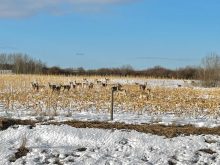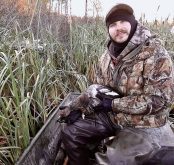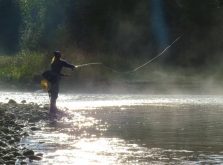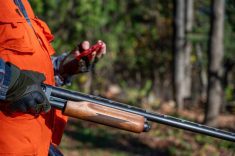My most vivid hunting memories from youth are of duck hunting with my dad and brother. Our cottage was a short drive from wild rice marshes that filled with migrating “bluebills” – lesser scaups and ring-necked ducks, nicknamed for their distinctive bill colour.
There were many more hunters back then. Competition for the best spots was fierce. One lake, with only a few good vantage points, sometimes had hunters head out the night before, sleeping fitfully in their boats to get first dibs in the morning.
Demand in our area was less extreme, but we convinced Dad that we had to beat the rush. After launching our small boat in the dark — I remember being guided by northern lights one morning — we motored up the river to our favourite spot, set out our few decoys and huddled in wait for over an hour.
Read Also

Manitoba farmers uneasy on expropriation
Farmland expropriation for Oak Bluff highway project brings process, farmer compensation concerns back to the fore.
At first, we only heard the rush of wings as early flocks streamed by, the sound amplifying our expectations. Then we could make out the still inky silhouettes blitzing over the decoys. Time seemed to stand still in those moments before legal shooting time (30 minutes before sunrise), when Dad would finally declare, “We can hunt.”
Duck hunting and sunrises go hand in hand. My love of this special time of day is, in part, tied to mornings in the duck blind.
Why it matters: Hunting season for ducks, coots and snipe opened Sept. 1 for Manitoba and Canadian residents and runs until Oct.31, Nov. 30 or Dec. 6, depending on hunting area. Check the 2024 Manitoba Hunting Guide to see which dates apply to which regions.

Manitoba is one of Canada’s three Prairie provinces, but I sometimes think “wetland province” would be more accurate. About 40 per cent of Manitoba is covered by wetlands and peatlands. Southwestern Manitoba is part of the continent’s prairie pothole region, also known in some circles as North America’s duck factory. Over half of North America’s ducks are raised there.
You can see why waterfowl — ducks, geese and swans — are prominent here. We see three main groups of ducks: dabblers, divers and mergansers.
Because of their specialized fish diet, mergansers (often called fish ducks) taste pretty much like the name suggests. Hunters don’t target them, so I will leave them out of this discussion.
Dabbling ducks, also called puddle ducks, include mallard, pintail, teal, wigeon, gadwall, shoveler and wood ducks. These populate the smaller, shallower wetlands that dominate the prairie and aspen parkland regions, although they’re also seen on the water in forested regions. Dabblers feed at the surface. They tip, butts sticking up in the air, to forage just below. They mostly eat vegetation.
Diving ducks include canvasback, redhead, scaup, ring-necked, goldeneye and bufflehead. They dominate deeper wetlands and shallow lakes in our aspen parkland, mixed woods and boreal forest region. Divers are more heavily built, have smaller wings and need to run across the water to take off. They mostly swim to the bottom to take vegetation, insects, crustaceans or small clams. The diving ducks we see in the fall have mostly migrated from more northern areas, especially scaup and ring-necked ducks.
Most duck hunters target dabbling ducks, especially mallards. A smaller group targets diving ducks, which often requires more gear and a willingness to face more adverse conditions.
Going after the dabblers
Marsh hunting for dabbling ducks means focusing on smaller, shallower wetlands or the shallow areas of large wetlands.
The first order of business is advance scouting. That may include talking to fellow waterfowl hunters who are willing to provide intel. Traditional waterfowl migration stopover areas, like Delta Marsh, the Oak and Plum Lake marshes, Whitewater Lake and innumerable wetlands and shallow lakes of the Minnesota and Shoal Lake pothole region, are well-known haunts for dabblers as well as divers, depending on location. This has led to hunting traditions that may span generations.
But opportunities also abound in less well-known areas if the hunter takes the time to find them. Good duck hunting comes from a set of binoculars and a willingness to take the occasional drive.

After you’ve found a marsh well used by ducks, look more closely to learn where they are resting or feeding and how they fly into the marsh. You should set up where birds want to settle or, at the least, where the birds will likely fly by in gun range.
Consider your blind location carefully. Is there good reed cover close to open water? How will it work in different wind directions? Birds usually fly into the wind when landing. With morning hunts, avoid east-facing setups on sunny days. Shooting into the sun is a pain.
When I hunt smaller marshes, I generally find that two dozen floating decoys are plenty. I often use fewer. I have tried the modern spinning wing decoys (you may have heard of robo-ducks), but I don’t think they are necessary if you have a good location. They won’t turn a bad spot into a good one.
The intricacies of decoy placement will generate passionate discussions among duck hunters. Many rely on a basic “J” pattern, where the bottom of the “J” is closer to the blind and the long arm stretches downwind and away from the hunter’s location. This creates an opening in your decoys fairly close to your blind (I like about 23 metres) to which flying ducks will be drawn, or so the theory goes.
When a hunt works out like that, enjoy your success. It often doesn’t, and you learn a bit more about the art of decoy placement.
Going big for diving ducks
Big water, including open areas in marshes and shallow lakes, and big decoy spreads are the norm when hunting for diving ducks. Through the autumn, these birds may be flying and feeding in open areas farther from shore, but which are still shallow enough to hold weed beds and other diving duck forage.
Diving ducks fly more frequently than dabbling ducks, especially in foul weather. A time-honoured approach is “pass shooting,” setting up in spots that funnel bird movements like a narrows in a large water body or a narrow neck of land between two basins. The south side of Riding Mountain National Park, where my brother lives, is rich with chains of shallow, productive lakes that attract diving ducks.
Pass shooting can work to great advantage, but trying to hit fast-flying birds is a challenge. One of my brother’s favoured spots is informally known as “Humble Pass” among his hunting companions due to all the misses. I count myself among the humbled.

In addition to pass shooting, diving ducks may be attracted to large spreads of decoys set in long lines leading upwind to a blind. Committed diving duck hunters will have many a dozen decoys deployed along flight paths that come close to potential blind locations.
The really committed ones hunt from layout boats in the middle of open areas. These are flat-bottomed, low-profile watercraft With the assistance of another hunter in a larger boat, long strings of decoys lead upwind to the anchored layout boat where the hunter is lying on his back, probably chattering in the cold.
If you are a committed diving duck hunter, you live for such experiences.
Equipment considerations
When I was a kid, most duck hunters owned a brown canvas hunting coat, a pair of hip waders, maybe a dozen decoys and a small fishing boat or canoe that did double duty during the hunting season. Today, like pretty much everything else, duck hunting has seen a proliferation of gear.
Beyond an appropriate gun, what are the basics? I wouldn’t hunt without chest waders (neoprene waders provide insulation against cold water). If you are hunting in a pond that gets beyond waist deep or has a really mucky bottom, a small boat is a must.

Canoes are excellent if you are comfortable in them. Otherwise, flat-bottomed rowing boats work. Add a camouflage hunting coat, some warm layers underneath, a hat and warm gloves, and you have a basic kit.
Most duck hunters use pump, semi-automatic or double-barrel 12-gauge shotguns. Guns need to handle steel shot (mandatory for waterfowl), and most people have guns that can take magnum as well as standard shells.
As for the rest, the sky is the limit as to what you might add to your duck hunting kit.
Ducks for dinner
My wife didn’t mind me continuing to hunt after our kids came along, but she had a stipulation: “You can’t force the kids to eat the game you bring home. Find recipes that make them want to eat it.”
I picked the brains of fellow hunters, hit the cookbooks and experimented. I must have done more right than wrong, because my now-grown children still look forward to eating ducks.
I pluck, dress and cool my birds right after a hunt. Back home, I soak them in salt water overnight to draw out blood that may have gotten into the meat.

My family thinks that ducks and barbecues are a marriage made in heaven. Careful knife work along the wish bone, breastbone and down the rib cage produces a single fillet holding breast and leg meat that will cook fairly evenly. These fillets also work well in the frying pan.
You can also spatchcock a plucked and cleaned bird (i.e. cut along the backbone and splay the bird out, which I do for smaller species). Breasts can be barbecued without the skin on, but intact skin makes for a far better result.
My standard marinade is soy sauce and apple juice, perked up with hot sauce, lime, garlic and ginger. Barbecuing over charcoal is best, but propane also works well.
This next part is key: don’t overcook the meat or it dries out and may start to taste gamey.
Wild game cookbooks offer other interesting options for waterfowl, but I think the barbecue wins, hands down.
The lure of ducks
I love walking the autumn woods for grouse and I treasure the solitude of the deer stand but, after more than five decades, duck hunting is still at the top of my list. The anticipation that builds while there are still stars in the sky, the magic of a misty marsh sunrise, the pure excitement of birds buzzing by the duck blind and delicious duck meals all drive my anticipation of autumn and my next trip to the marsh.



















